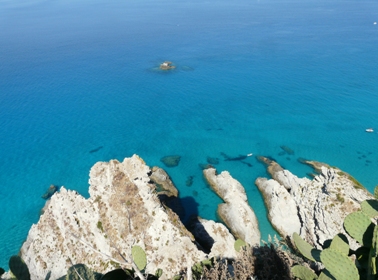
 Tropea, Capo Vaticano, Pizzo Calabro
Tropea, Capo Vaticano, Pizzo Calabro

filled by Giulia

Pearl of the Tyrrhenian coast, Tropea is situated on a beautiful and impressive rock overlooking the sea. It has a magnificent view of the sea that you can enjoy from the natural terraces of the town, the most beautiful in Piazza del Cannone. From here you can take a good photograph of the Convent of Santa Maria dell’Isola. This important Marian shrine is located in a lovely position on a spur of rock in the sea. In reality this ridge on which stands today is no longer an 'island, because of the silting that has connected to the mainland.
Tropea is a village with a rich variety of architectural styles from Norman to Art Nouveau to Arab. It’s immpressive to see the number of palaces that arise in the perimeter of the old town and dating back to 1600, as well as the large number of churches.
Inside, the narrow streets, the town hidden beautiful courtyards and handmade. Some buildings, with tanks dug into the rock, piled up the wheat from Monte Poro, which was then loaded on ships moored in the rock through clay pipes. For a peaceful outdoor dining away from the crowds that often animates the streets of Tropea you should go to Lamia, Largo Vulcano, a central square, but surprisingly quiet. We eat very well at Pentola D’Oro, in via Pelliccia, both inside and outside, and the staff is really nice. For overnight stays there are several very nice B & B, the most beautiful in Italy, and we thought Villa Victoria was the nicest, where breakfast is served in the garden, as well as apartments for rent. For those who want to spend a little more than suggest Hotel Villa antica, which offers colonial atmosphere.
Impossible not to dedicate the evening a little shopping of typical products:
Pecorino di Monte Poro, the spicy 'nduja, spreadable salami made with chili pepper, red onion, mostaccioli, sweet aromatic, licorice, both in tablets and in liquid.
From Tropea we suggest with the ship to reach the island of Stromboli with a day trip or even better night to watch the eruptions from the sea in front of the Sciara del Fuoco.
Not always the sea of Tropea is clean, especially if you go in August, and so we recommend you to go by boat to the nearby Cape Vaticano. Here, the beaches reachable only by sea, the water is quite another category, it's a transparent exaggeration, it’s not the same at all. To get an idea of what we are talking about, you can go there by car and stop at the end of the town where there is a panoramic view Walking on a short path you can look beyond the leaves of the prickly pears and be enchanted by surprise. We met a Calabrian who was there with his family next to us, he complained that Italy is full of paying places when this part is still absolutely free! (look at the picture to believe it).
After Capo Vaticano is found Pizzo Calabro. In one of the restaurants overlooking the Piazza della Repubblica you must taste a truffle. We went to Hercules, because understood the truffle was born right here. Excellent dining experience! For those who do not love chocolate hazelnut stuffed or there is a sliver of pistachio ...
In the square there is a rooftop terrace that broadens our gaze towards Tropea ...An elevator takes visitors from the center of the Aragonese Castle Peak.
Taste an appetizer on the spot before leaving the town: an appetizer made of octopus served with a glass of local wine, Zibibbio (the sweet white grapes typical of Pizzo), pepata di zozze and pitta lorda (stuffed pizza).
The Church of Santa Maria di Piedigrotta, a real gem, is at a five minutes drive. It 'a cave dug into the tuff rock that extends in many directions, with stalagmites carved and transformed into columns or statues. A series of natural arches and pillars separating the different chapels and caves that are home of a crib, a St. George and the dragon, angels, the Madonna of Pompei, the scene of the multiplication of the loaves and fishes and other biblical scenes. Legend says that around 1665 a Neapolitan ship crashed against the rocks. In those dramatic moments the captain prayed to the Madonna, whose picture was on board, so that might save the lives of the crew. The vessel sank but the men managed to reach shore, where today stands the church. On shore the sailors found themselves the image of the Madonna. As thanks for the miraculous rescue a small chapel was built on the rock and there they placed the sacred image. There were other storms, and the picture, taken away by the fury of the waves, was always found in the place where the ship had crashed against the rocks. Soon the place became a meeting point for sailors and their boats crossed the stretch of sea and even pizzitiani affectionate to the Madonnella, enlarged the cave.
|
|






















